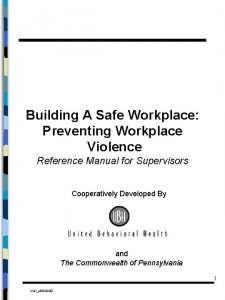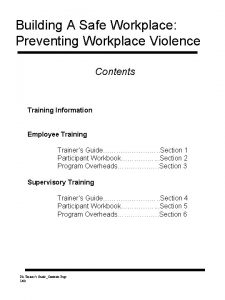Creating a Psychologically Safe Workplace Three Strategies for











- Slides: 11

Creating a Psychologically Safe Workplace Three Strategies for Effective Team Interaction INFO@PPLDEV. COM Scott Gardner Antoinette Joy Dennis Wade Tyler Wade

Objectives By the end of this presentation, you will know: • What psychological safety is and why it matters • The symptoms for recognizing when your team lacks psychological safety • Strategies for building psychological safety on your team • A specific tool and technique for building psychological safety on your team 2

What is Psychological Safety (PS)? • A belief: the team is a safe place for taking risks • Team members won’t embarrass or punish each other for: • Making a mistake • Asking a question • Offering a new idea • It doesn’t mean your ideas won’t be challenged or you won’t like the answer • It means you get the best from team members 3

Dynamics of Effective Teams 4

5

6

Symptoms of a team lacking PS • Team members will: • • Conceal their weaknesses and mistakes from others Hesitate to ask for help or provide constructive feedback Waste time and energy managing their behaviors for effect Hold grudges Dread meetings and find reasons to avoid spending time together Have boring or irrelevant meetings Ignore controversial topics that are crucial to team success Have a meeting outside of the meeting 7

Three strategies for building PS • Demonstrate engagement • Be present – put away your laptop and smartphone • Offer input • Check body language and facial expressions • Show understanding • Validate comments • Ask questions for understanding • Focus on the situation or issue, not the person • Be inclusive • • • Express gratitude Be approachable Solicit input, opinions, and feedback from teammates Don’t interrupt Respect the agreed-upon decision-making method 8

A tool for building PS: A Team Operating Agreement (TOA) • A team operating agreement – what is it? • Why have a team operating agreement? • How to create one • Exercise • Individually, read through the operating agreement handout and: • Check items your team currently does • Circle items you would like to start doing (three minutes) 9

A technique for building a TOA: The Nominal Group Technique • Benefits of the Nominal Group Technique • Exercise • Individually, brainwrite as if you were back at work building a TOA • At your table, a facilitator will collect ideas on a flipchart • Be ready to share what’s on your group’s TOA 10

Thank you! • • Final questions or comments? Next steps info@ppldev. com Bibliography • re: Work, www. rework. withgoogle. com/guides • The Five Dysfunctions of a Team, Patrick Lencioni • The Five Keys to a Successful Google Team, Julia Rozovsky 11
 Solace american pie
Solace american pie Psychologically informed environments
Psychologically informed environments Psychologically informed environments
Psychologically informed environments Psychologically informed environment
Psychologically informed environment Inner defender and inner guide examples
Inner defender and inner guide examples On course strategies for creating success in college
On course strategies for creating success in college Safe feed safe food
Safe feed safe food Safe people safe places
Safe people safe places Three market segmentation strategies
Three market segmentation strategies Three strategies for handling anger in a healthful way
Three strategies for handling anger in a healthful way Market segmentation and strategic targeting
Market segmentation and strategic targeting Kontinuitetshantering i praktiken
Kontinuitetshantering i praktiken


















